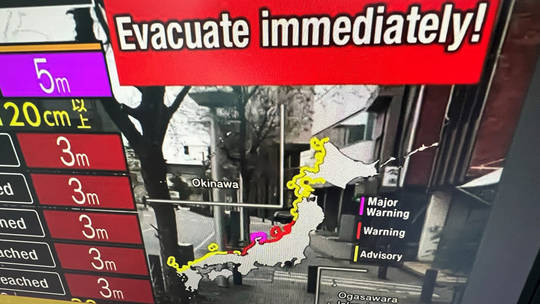Tsunami warning issued after powerful earthquake strikes Japan
01.01.2024 14:35
 Tsunami warning issued after powerful earthquake strikes Japan
Tsunami warning issued after powerful earthquake strikes Japan
Photo: Mladen ANTONOV / AFP
In March 2011, the country was battered by devastating tremors and gigantic waves that left 18,000 dead and caused meltdowns at the Fukushima nuclear power plant – the biggest such incident since the 1986 Chernobyl explosion in Soviet Ukraine.
The initial quake measured seven, the maximum intensity specified by the Japan Meteorological Agency’s Shindo seismic scale, which assesses the tremor’s severity at the surface.
Several aftershocks followed, with the agency issuing a tsunami warning for coastal Ishikawa, Niigata, Toyama and Yamagata prefectures.
Speaking to reporters, Prime Minister Fumio Kishida appealed to people living “in areas where tsunamis are expected,” saying “I would like to request that they evacuate as soon as possible.”
According to the national broadcaster NHK, waves in some areas may have reached a height of 5 meters.
Government spokesman Hayashi Yoshimasa said during an emergency press conference that authorities were evaluating the extent of the damage caused by the earthquake and warned people to be ready for further tremors.
Meanwhile, multiple video clips posted on social media depict cracks in roads, partly collapsed buildings and a fire.
Japan’s Nuclear Regulation Authority reported in a post on X (formerly Twitter) that the natural disaster has “caused damage to the Shiga Nuclear Power Plant in Shiga Town, Ishikawa Prefecture (maximum seismic intensity 7), and the Kashiwazaki-Kariwa Nuclear Power Plant in Kashiwazaki City and Kariwa Village, Niigata Prefecture (maximum seismic intensity 5+).”
Officials hastened to add, however, that no “abnormalities” have been detected, with the watchdog continuing to monitor all the nuclear power plants in the affected areas.
While some of these facilities were not in operation at the time of the earthquake, the Kashiwazaki-Kariwa nuclear power plant was put back online last Wednesday for the first time since 2012.
South Korea’s meteorological agency has notified citizens that sea levels off its eastern coast could rise as well.
Authorities in the Russian island region of Sakhalin have also issued a tsunami alert.
